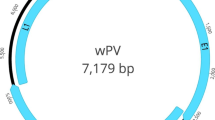Summary
Northern pike from several locations in central Canada were observed to have two different types of hyperplastic epidermal lesions on the body and fins. One type of epidermal hyperplasia consisted of flat lesions, bluish-white in color with a granular or “gritty” appearance. Histological examination of this granular lesion showed the presence of grossly hypertrophied cells surrounded by normal sized epidermal cells. The enlarged nuclei in thin section contained many typical herpesvirus capsids measuring 100 nm in diameter. A large proportion of the cytoplasmic mass consisted of many dark staining inclusions in which were embedded numerous herpes-like virions. For this herpesvirus of pike the name esocid herpesvirus 1 is proposed in keeping with the herpesvirus nomenclature ofRoizman et al. (19).
The second type of epidermal hyperplasia was a smooth convex whitish translucent tissue mass consisting largely of a population of randomly oriented normal sized undifferentiated cells. Electron microscopic examination showed them to be associated with clusters of C-type retrovirus measuring 150 nm in diameter. The formation of these virus particles was by budding from the cytoplasmic membrane into the inter-cellular spaces.
Neither the herpesvirus nor the C-type particles could be isolated in fish cell cultures.
Similar content being viewed by others
References
Amin, O. M.: Lymphocystis disease in Wisconsin fishes. J. Fish Dis.2, 207–217 (1979).
Barile, M. F.: Mycoplasma contamination of cell cultures. In:Seligson, D., Hsiung, G. D., Green, R. H. (eds.), CRC Handbook Series in Clinical Laboratory Science Section H: Virology and Rickettsiology, Vol. 1, Part 2, 381–406. West Palm Beach: CRC Press 1978.
Buchanan, J. S., Madeley, C. R.: Studies onHerpesvirus scophthalami infection of turbotScophthalamus maximus (L.): ultrastructural observations. J. Fish Dis.1, 283–295 (1978).
Buchanan, J. S., Richards, R. H., Sommerville, C. S., Madeley, C. R.: A herpes-type virus from the turbotScophthalamus maximum (L.). Vet. Rec.102, 527–528 (1978).
Craighead, J. E., Kanich, R. E., Almeida, J. D.: Nonviral microbodies with viral antigenicity produced in cytomegalovirus-infected cells. J. Virol.10, 766–775 (1972).
Dahlberg, J. E.: Retraviridae: RNA tumor viruses. In:Seligson, D., Hsiung, G. D., Green, R. H. (eds.), CRC Handbook Series in Clinical Laboratory Science Section H: Virology and Rickettsiology Vol. 1, Part 1, 323–335. West Palm Beach: CRC Press 1978.
Dalton, A. J., Melnick, J. L., Bauer, H., Bundreau, G., Bentvelzen, P., Belognesi, D., Gallo, R., Graffi, A., Hagenau, F., Heston, W., Huebner, R., Todaro, G., Heine, U. I.: The case for a family of reverse transcriptase viruses: retraviridae. Intervirology4, 201 (1974).
Darlington, R. W., Moss, III. Howard, L.: The envelope of herpesvirus. Prog. Med. Virol.11, 16–45 (1969).
Fong, C. K. Y., Bia, F., Hsiug, G. D., Madore, P., Chang, P. W.: Ultrastructural development of guinea pig cytomegalovirus in cultured guinea pig embryo cells. J. gen. Virol.42, 127–140 (1979).
Iwasaki, Y., Furukawa, T., Plotkin, S., Koprowski, H.: Ultrastructural study on the sequence of human cytomegalovirus infection in human diploid cells. Arch. ges. Virusforsch.40, 311–324 (1973).
Kanich, R. E., Craighead, J. E.: Human cytomegalovirus infection of cultured fibroblasts. I. Cytopathic effects induced by an adapted and a wild strain. Lab. Invest.27, 263–272 (1972).
Kaplan, A. S.: The herpesviruses, 1–739. New York: Academic Press 1973.
Kelly, R. K., Nielsen, O., Mitchell, S. C., Yamamoto, T.: Characterization ofHerpesvirus vitreum isolated from hyperplastic epidermal tissue of walleye,Stizostedion vitreum vitreum (Mitchill). J. Fish Dis.6, 249–260 (1983).
Ljunberg, O.: Epizootiological and experimental studies of skin tumors in northern pike (Esox lucius L.) in the Baltic Sea. In:Homberger, F., Dawe, C. J., Scarpelli, D.G., Wellings, S., Jr. (eds.), Prog. exp. Tumor Res. Vol. 20, 156–165. Basel: Karger 1979.
Ljunberg, O., Lange, J.: Skin tumors of Northern Pike (Esox lucius L). I. Sarcoma in a Baltic pike population. Bull. Off. Int. Epizoot.69, 1007–1022 (1968).
McGavran, M. H., Smith, M. G.: Ultrastructural, cytochemical and microchemical observations on cytomegalovirus (salivary gland virus) infection of human cells in tissue cultures. Expl. Mol. Path.4, 1–10 (1965).
Mulcahy, M. F., O'Rourke, F. J.: Lymphosarcoma in the pike,Esox lucius L. (Pisces, Esocidae) in Ireland. Proc. R. Ir. Acad.63, 103–129 (1963).
Richards, R. H., Buchanan, J. S.: Studies onHerpesvirus scophthalami infection of turbotScophthalamus maximus (L.), histopathological observations: J. Fish Dis.1, 251–258 (1978).
Roizman, B., Carmichael, L. E., Dienhardt, F., de-The, G., Nahimias, A. J., Plowright, W., Rapp, F., Sheldrick, P., Takahashi, M., Wolf, K.: Herpesviridae: definition, provisional nomenclature and taxonomy. Intervirology16 (1981).
Schubert, G. H.: The infective agent in carp pox. Bull. Off. Int. Epizoot.65, 1011–1022 (1966).
Sonstegard, R. A.: Lymphosarcoma in muskellunge. In:Ribelin, W. E., Migaki, G. (eds.), Pathology of Fishes, 907–924. Madison: Univ. Wisconsin Press 1975.
Sonstegard, R. A.: Studies of the etiology and epizootiology ofLymphosarcoma inEsox (Esox lucius L. andEsox masquinongy). In:Homberger, F., Dawe, C. J., Scarpelli, D. G., Wellings, S. R. (eds.), Prog. exp. Tumor Res. Vol. 20, 141–155. Basel: Karger 1976.
Walker, R.: Fine structure of lymphocystis virus of fish. Virology18, 503–505 (1962).
Walker, R., Weissenberg, R.: Conformity of light and electron microscopic studies on virus particle distribution on Lymphocystos tumor cells of fish. Ann. N.Y. Acad. Sci.126, 375–395 (1965).
Winqvist, G., Ljungberg, O., Hellstroem, B.: Skin tumors of Northern Pike (Esox lucius L.) II. Viral particles in epidermal proliferations. Bull. Off. Int. Epizoot.69, 1023–1031 (1968).
Winqvist, G., Ljunberg, O., Ivarsson, B.: Electron microscopy of sarcoma of the northern pike (Esox lucius L.). In:Dutcher, R. M., Chieco-Blanchi, L. (eds.), Unifying Concepts of Leukemia. Bibl. Haemat. No. 39, 26–30. Basel: Karger 1973.
Yamamoto, T., MacDonald, R. D., Gillespie, D. C., Kelly, R. K.: Viruses associated with lymphocystis disease and dermal sarcoma of walleye(Stizostedion vitreum vitreum). J. Fish. Res. Board Can.33, 2408–2419 (1976).
Author information
Authors and Affiliations
Additional information
With 15 Figures
Rights and permissions
About this article
Cite this article
Yamamoto, T., Kelly, R.K. & Nielsen, O. Epidermal hyperplasias of northern pike(Esox lucius) associated with herpesvirus and C-type particles. Archives of Virology 79, 255–272 (1984). https://doi.org/10.1007/BF01310815
Received:
Accepted:
Issue Date:
DOI: https://doi.org/10.1007/BF01310815




